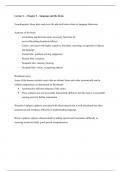Lecture 2 – Chapter 3 – language and the brain
Neurolinguists: those who study how the physical brain relates to language behaviour
Anatomy of the brain:
- Cerebellum and the brain stem: necessary functions for
survival/breathing/heartbeat/reflexes
- Cortex: associated with higher cognitive functions: reasoning, recognition of objects
and language
- Frontal lobe: problem-solving, judgement
- Parietal lobe: sensation
- Temporal lobe: memory, hearing
- Occipital lobe: vision, recognizing objects
Brodmann areas:
Areas of the human cerebral cortex that are distinct from each other anatomically and in
cellular composition, as determined by Brodmann
Anatomically different subareas of the cortex
These subareas are not necessarily functionally different, but this map is a reasonable
starting point for further exploration
Wernicke’s aphasia: aphasia associated with fluent speech that is well articulated but often
nonsensical and enormous difficulty in understanding language.
Borca’s aphasia: aphasia characterized by halting speech and tremendous difficulty in
choosing words but fairly good speech comprehension.
,Lecture 3 – Chapter 2: Origins of Human Language
Language = a tool for solving certain problems that all humans have and to transmit
information to each other
- Nativist view: the view that not only are humans genetically programmed to have a
general capacity for language, particular aspects of language ability are also
genetically specified.
- Anti-nativist view: the view that the ability of humans to learn language is not the
result of a genetically programmed ‘language template’, but is an aspect of our
extensive cognitive abilities, including general abilities of learning and memory
- Language of bees à performing a dance, to show a specific path to a good source of
nectar. What do they communicate? The direction in which the nectar source is
located, the distance to the source and the quality of the source.
o It’s a symbolic representation they’re drawing a map while shaking their
bodies. Honeybee communicative behavior shows that a complex behavior
capable of transmitting information about the real world can be encoded in the
genes and innately specified through an evolutionary process.
- Primate vocalizations humans learn words through the process of cultural
transmission, but vervets learn by being genetically wired to make specific sounds that
are associated with specific meanings.
o Vervets lack Hockett’s feature of displacement, duality of patterning,
productivity. Vervets don’t seem to have the capacity to learn to make various
alarm calls.
o Chimpanzee’s fail to follow pointing cues. They often understand the
intentions and goals, but they can’t understand that pointing involves an
intention to communicate
o Human cognitive skills and motivational drives are refined, either specifically
for the purpose of communication, or more generally to support complex social
coordination.
o Toddlers and chimpanzees are about even with each other in understanding the
physical world. But when it comes to the social test, the toddlers left the other
primates in the dust. Apes don’t seem to be inclined to communicate with other
apes for the purpose of helping the others to achieve a goal, but toddles almost
feel compelled to.
, o Humans are inclined to share information with one another, whereas other
primates seem not to have discovered
Hocketts design features: A set of characteristics proposed by linguist Hockett to be
universally shared by all human languages. Some, but not all, of the features are also found in
various animal communication systems.
1. Vocal-auditory channel: language is produced in the coal tract and transmitted as
sound. Sound is perceived through the auditory channel. (channel)
2. Broadcast transmission and directional reception: language can be heard from many
directions, but it is perceived as coming from one particular location. (channel)
3. Rapid fading: the sound produced by speech fades quickly. (channel)
4. Interchangeability: a user of a language sends and receives the same message.
(interactive aspects of language)
5. Total feedback: senders of a message can hear and internalize the message they’ve
send. (interactive aspects of language)
6. Specialization: the production of the sounds of language serves no purpose other than
to communicate.
7. Semanticity: there are fixed associations between units of language and aspects of the
world. (content and structure of language)
8. Arbitrariness: the meaningful associations between language and the world are
arbitrary (=willekeurig). (content and structure of language)
9. Discreteness: the units of language are separate and distinct from one another rather
than being part of a continuous whole. (content and structure of language)
10. Displacement: language can be used to communicate about things that are not present
in time and/or space. (content and structure of language)
11. Productivity: language can be used to say things that have never been said before and
yet are understandable to the receiver. Using the symbols, they know in new
combinations to communicate ideas for which they don’t already have symbols.
(content and structure of language)
12. Traditional transmission: the specific language that’s adopted by the user has to be
learned by exposure to other users of that language; its precise details are not available
through transmission. (interactive aspects of language/content and structure of
language/not unique to language)




